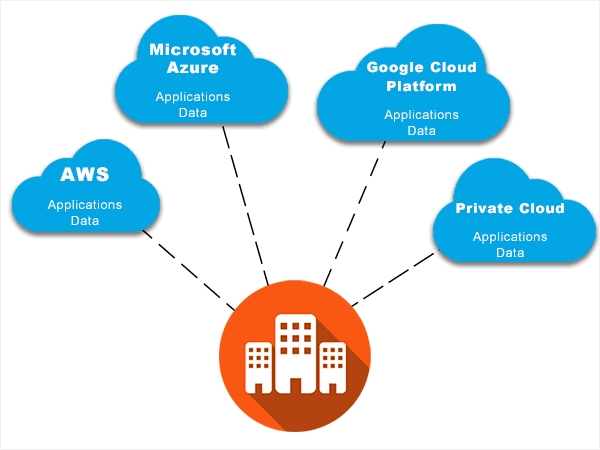
The Ultimate Guide to Hiring a Project Manager
March 5, 2022
Top 5 Javascript Frameworks You Need to Know About in 2022
March 5, 2022
Multi-Cloud Management: An In-Depth Guide

Most organizations are adopting a multi-cloud strategy. But juggling between various cloud providers isn't always straightforward. Most IT professionals are baffled by the term multi-cloud. Organizations that invest in a multi-cloud environment could benefit from increased scalability, improved security, improved disaster recovery, and other benefits. On the other hand, effective multi-cloud administration is critical for making the most of the capabilities provided by cloud service providers. This post discusses the challenges, best practices, and the most critical features of multi-cloud management solutions to assist you in making the best decision. It is essential to acknowledge that each organization has different needs. Thus, it would be best to optimize your cloud environment to ensure the best possible results for your use case. According to a report by Gartner, it is expected that 75 per cent of enterprise customers using the IaaS deployment model will adopt a multi-cloud strategy by 2022. An effective multi-cloud strategy can help organizations minimize third-party risks associated with cloud adoption, which can prove beneficial in an outage. This guide aims to educate you about the opportunities a multi-cloud strategy can provide and the common pitfalls to make an informed decision regarding your organization's cloud strategy.
What is Multi-Cloud Management?

Cloud management solutions are in high demand as more enterprises move their applications to private and public clouds. Given that most organizations utilize more than one public cloud service provider, multi-cloud management allows for the establishment of a consistent and uniform cloud management system. It allows IT teams to manage numerous clouds from a single interface and support multiple cloud platforms (AWS and Azure) and new tools like Kubernetes. In a nutshell, it manages massive amounts of data to keep a single cloud platform from becoming overburdened. This combination of tools and procedures allows a company to keep track of and secure its apps and workloads on numerous public clouds.
For multi-cloud administration, the utilization of containers and Kubernetes is essential. App developers can easily create cloud-deployable applications with containers since they package all required dependencies and services in a tiny package. The containers can then be managed, deployed, and automated via Kubernetes.
Benefits of Multi-Cloud Management

Scalability
Multi-cloud provides a considerable advantage in terms of scalability. In addition to providing an optimal environment for processing and storing information, multi-cloud computing also allows for proper automation and real-time synchronization. It is also a fantastic choice for storage and scalability since it enables organizations to adjust their storage capacity up or down in response to changing demand conditions.
Avoiding Vendor lock-in
Businesses can avoid being tied to a single service provider by implementing a multi-cloud strategy. Companies can deploy specialized services using a multi-cloud approach instead of relying on a single provider for their software requirements. As a result, businesses can be confident that they provide their workers with the most up-to-date solutions and software.
Risk Mitigation
The ability to effectively manage risk is another advantage of multi-cloud management. A multi-cloud customer, for example, can swiftly transfer to another cloud service provider or back to a private cloud in the event of infrastructure failure or assault. Vulnerability testing, API asset aggregation, and robust authentication procedures are some of the services offered by multi-cloud providers to mitigate the risks.
Employing Best-in-Class Cloud Solution for Each Purpose
A company's IT strategy can be aligned with the finest cloud-hosting providers for each activity if it incorporates various clouds. As a result, your organization will be able to take advantage of the most excellent possible solution for each use case.
Multi-Cloud Management: Best Practices

Use of Containers
The ability to package programmes with all of their dependencies improves portability and can make application administration easier in most cases. It facilitates migrating an application between different cloud environments simpler and less disruptive to the application's performance.
Analytics
The platform should be able to provide a deep analysis of the activities of a cloud. The inclusion of key indicators and forecasts about future behavior, such as performance or dependability, is also required. The vast amounts of data can be analyzed and the performance of each cloud service provider must be measured against the service of other cloud service providers. A cost-benefit analysis can lead to increase in productivity while reducing cloud expenses significantly.
Standardized consumption
During multi-cloud environment development, each business unit inside an organization may employ services from a variety of different providers, such as an analytics platform from Microsoft Azure, storage from Amazon Web Services, and artificial intelligence capabilities from the IBM Cloud. Business units frequently use various payment methods to cover the costs of these services. To properly allocate resources, it is necessary to track the consumption of each department and adjust the number of resources allocated correspondingly.
How Atidan Technologies Can Help You With Your Cloud Adoption Goals

Atidan specializes in helping your business realize its true potential with the help of the latest technologies to make sure that you come out ahead. With decades of experience and a tremendously powerful platform, our goal is to help you realize the full potential of today's cutting-edge technologies. With a presence in over 14 countries, We have software engineers that can help you maximize your technology investments and bring new efficiencies to your business. Our team of developers, architects, and specialists bring a diverse array of technology frameworks and a rock-solid approach to ensure your application works seamlessly. In addition, Atidan’s expert consultants will work actively with your business process managers, IT staff, and executive leadership to identify your requirements and help you reach your business goals. Planning and executing an impeccable cloud adoption strategy can be made easy with the help of Atidan.

